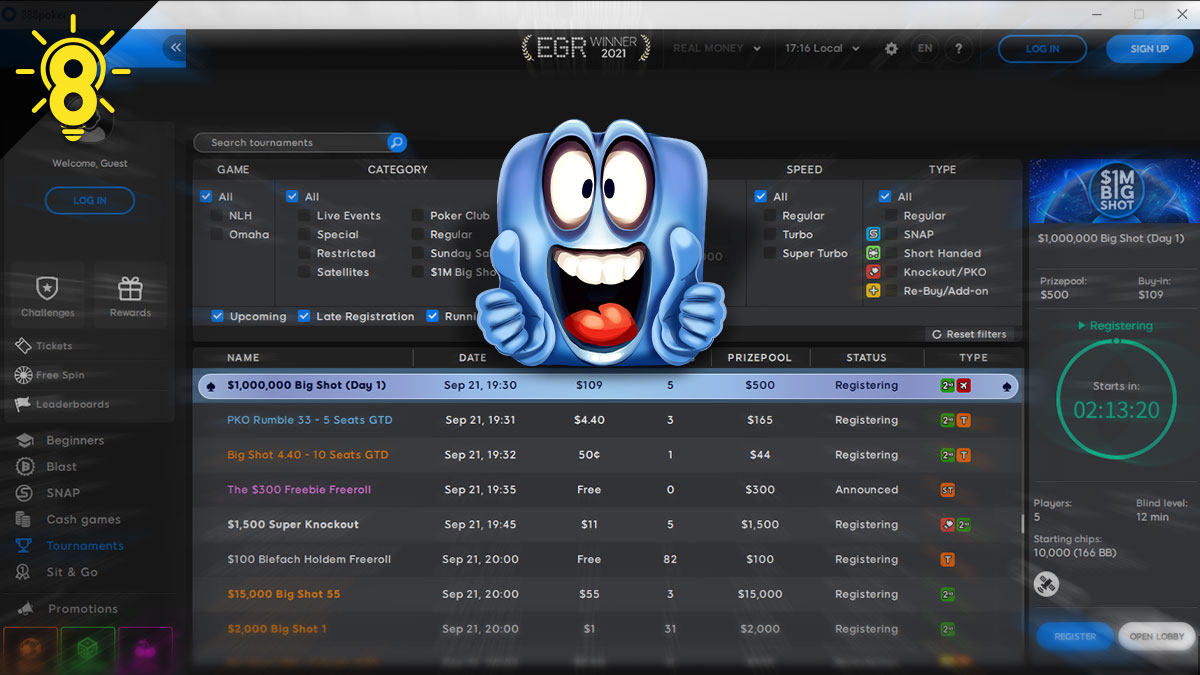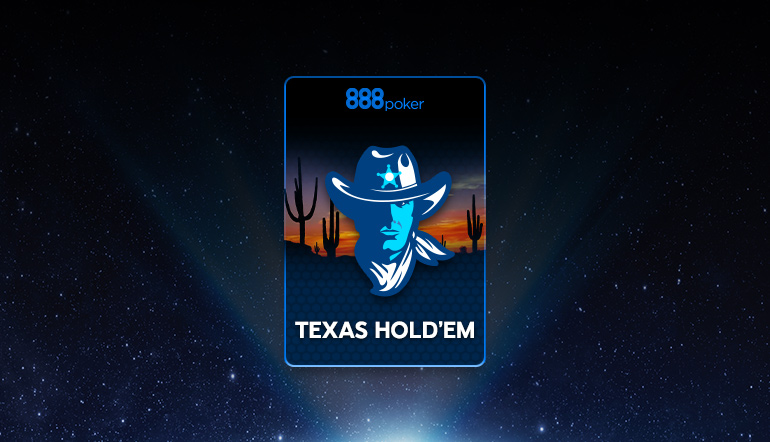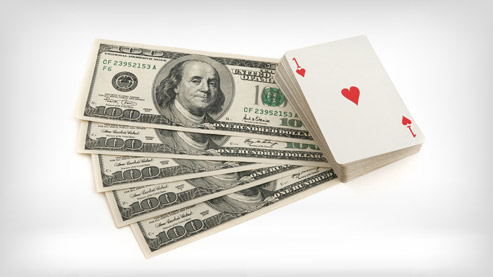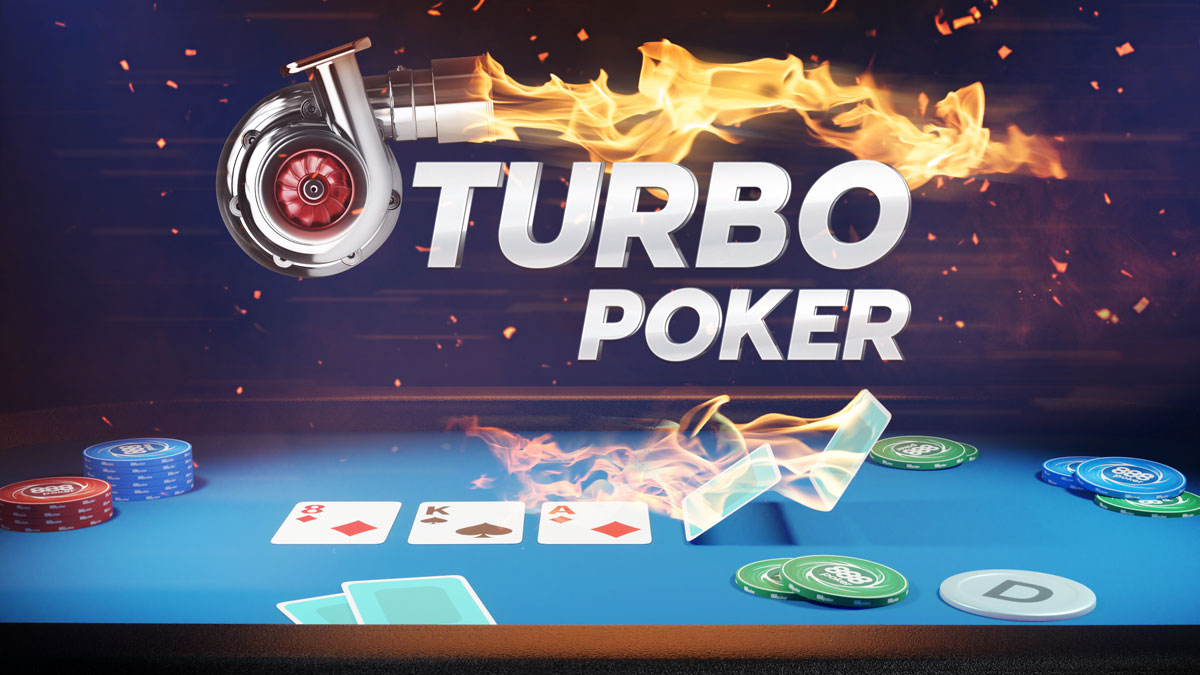If you're chasing the dream, tournament poker is probably the answer to every player's fantasy. What's not to like about taking down a title, with life changing sums of money thrown in for good measure?
However, many players simply become dead money in poker tournaments. They have little, or no chance, of making the final table or winning. Don't let that be you!
The Best Poker Tournament Tips Are:
- Play the late stages of the tournament much more aggressively than the early ones.
- Never let your stack fall below 10 big blinds, and simply push or fold when the time is right.
- Look closely at the situation and adjust your bet sizing accordingly.
- Don't Assume that you “own” the chips in your stack.
- Look for opportunities where your chances of winning, by being aggressive, are highest.
But, you can change all that with a solid Texas Hold'em Tournament Strategy plan. And, of course, you will need to be able to make that plan work to win. In this guide, we'll show you how to become a tough tournament player. No one will mistake your buy-in as a stepping stone to their success, ever again.
Tournament Poker Strategy: Main Components
Firstly, we'll discuss the 5 key poker tournament strategy tips that novices and intermediate tournament players need to concentrate on to become tough tournament opponents. You know, the sort of player nobody wants to look up and see at their table.
With that said, having too much to remember and think about during a tournament can be just as bad. These 5 basic tips will help you stay focused on the task at hand while providing a solid foundation to build on for future learning.
Now it's time to arm yourself for the next time you go in to do battle...
1. Getting through the Beginning, Middle & Late Stages
All poker tournaments have a beginning, middle and late stage. However, many players simply play each stage the same way. As a rule of thumb, you should play the late stages of the tournament much more aggressively than the early ones.
One big reason for this is that the blinds are at their smallest at the start. There is no need to take big risks in order to pick up extra chips. On top of that, if you can create the image of a tight player, you'll get more respect when you open up your game (play more hands in position) in the later stages.
Playing A-9 off-suit in the Early and Late Stages of an MTT
A hand like A-9 off-suit could easily hit the muck pre-flop in the early stages of an MTT. In the late stages, post bubble, this hand becomes much more playable. You can bring it in for a raise and even 3-bet with it, in position.
As the tournament progresses, more players are eliminated and the blinds increase. Now is the time when you should take more risks. With bigger blinds, your chip stack to blind ratio gets smaller and smaller. If you try to sit it out, waiting for premium hands, you'll end up getting blinded out. And, that's no fun!
Players all around you, both on your table and on other tables, are winning big pots and amassing sizeable stacks. The big stacks are getting bigger, and the tournament leaders are pulling further away.
So, in the middle stages, you need to get busy. In this phase, the button becomes your best friend. As the more aggressive players try to build bigger stacks, the weaker ones will be keen on folding their way to the money. Pounce on them! Use their fear to your advantage, when in position, with a view to stealing blinds. In the later parts of a tourney, the blinds are much bigger, and the overall risk can be worth it. You should also open up your starting hand range to include ones that can crack over pairs. Suited connectors and small pairs (with a view to set-mining) are good candidates.
In the later stages, chip preservation is key. Building your stack is still important. But why risk huge chunks of chips that have taken you two earlier stages to amass? Identify the survivalists and prey on their fear of busting out.
So, for new tournament players, a good default strategy is to start out tightly during the first few levels. As the tourney continues, open up your ranges, by at least double during each phase of play. By aiming for this goal, you should survive the early rounds and get into the middle stages almost every time.
2. Push of Fold?
Let's start by saying if you just remember to never let your stack fall below 10 big blinds, and simply push or fold when the time is right, you will become much better tournament player. No questions asked!
However, despite having a solid plan sometimes nothing will have gone your way and your stack will have fallen off. When this happens, you'll be forced to take risks you wouldn't normally take. Chips will be at an all-time premium and getting them will take a huge amount of fearlessness. That doesn't mean going all-in at the drop of a hat! Note that this section is called, “Push or Fold?” - not “Whatever, I'm All-in!”.
For example, you're in an MTT entering the middle stages. There is a 4xBB raise and then a 3bet (re-raise) all-in behind that. With the blinds at 100/200, risking your remaining $2K chips with Ace-rag is crazy. This situation is where the concept of “push or fold” comes into play. In this situation, you can only win with the best hand at showdown. Folding and waiting for a better spot – even with 10BB left in your stack – is proper.
In general, you can really only call all-in short-stacked, if you have a very powerful hand like AA or KK, or your stack is so low that you have no other option. When you're at the stage where your stack falls so low, you should be pushing all-in regardless. There's no time for tip-toeing around, waiting for the poker gods to smile on you.
On the other hand, if you decide to push all-in pre-flop with a mediocre hand, you double your chances of winning. Why? Everyone could fold and you'd scoop in the blinds. If you're called, you can still get lucky and win at showdown. When it comes to multi-way post-flop action, knowing when to push or fold gets a little hairy. The more people you have to face, the less your chances of winning.
There are a lot of charts that you can use to figure out whether to push or fold. The one below is specific to the button, but you can pretty much find ones from every position at the table.
3. Bet Sizing for Tournaments
Bet sizing can be the difference between making a final table and busting early. There are basically two times in a tournament where bet sizing comes into play - pre-flop and post-flop. Let's look at both:
- Pre-flop Bet Sizing
In all tournaments, you should have a pre-flop raise that falls in line with what's happening at your table. It has to make sense to your opponents. Raising to 5xBB when everyone else is doing 2.5xBB will put a spotlight on you.
For some players this sort of strategy works. However, for beginners, sticking to a standard pre-flop raise amount is best. Now as the tournament progresses you can vary this amount up or down slightly, based on your stack size.
- Post-flop Bet Sizing
Once the flop is out – all bets are on! Now you really have to know what you are doing. In nearly all situations, where you were the pre-flop raiser, you should be betting! Around 50-70% of the pot is a good continuation-bet size (c-bet).
This amount will help define the strength of your hand – letting your opponents know that you have a decent holding. Any smaller and you could get raised or check- raised. Any larger and you could find yourself committed to calling an all-in with a mediocre holding.
Let's look at an example of proper c-bet sizing:
You're in the early stages of an MTT with the blinds at 25/50. You raise 2.5xBB from the Hijack with Ad-Qs. The Button calls, the SB folds and the BB calls. The flop comes down Qh-9d-2s. Now you have top pair with top kicker. You'll have to be slightly concerned that Q-9 suited could be in the hand, but the board looks pretty tame. A c-bet of 2/3 pot would be a good play. It'll weed out the middle pairs and reel in the Q with a weaker kicker.
As the tournament enters the later stages, you can down this number to around 25- 30% of the pot. Remember, your chips are worth more, and you want to hold onto them. This isn't the time for overly-aggressive betting with air. It's even more important to control the pot size and your opponents' betting.
- Pre-flop 3bet Bet Sizing
Figuring out the right amount the 3bet can be challenging, especially with callers in between. Say, you're in the middle stages of a tourney (with 45BB) and wake up on the Cut-off with AK suited. Middle position (with 30BB behind) open-raises to 2.5xBB and the Hijack player (with 25BB) calls.
You'd like to put in a healthy 3bet here, but what would be a fair amount? Seeing as you will have position on your opponents for the rest of the hand a 3x the original raise is decent. But what about the caller in between? Ah, in multi-way pots, you have to account for that extra money and possible 3bet caller. Add 1x the original raise for each one. In this instance there is one caller – besides the raiser, so your 3bet should be 4x the original raise.
Now when you're out of position, you should set your 3bet at 4x the original raise when facing one opponent. With multiple callers, add 1x for each and another 1-2x the original raise. This amount will protect your hand and weed out any potential flop hanger-ons.
Always remember to look closely at the situation and adjust your bet sizing accordingly. It could be the difference between winning and losing the hand.
4. Making the Final Table
In this section, we are going to give you some time honoured advice for getting to that “holy grail” of poker – the Final Table. Firstly, don't ever commit the cardinal sin of all cardinal sins in tournament poker: Assuming that you “own” the chips in your stack. This isn't a cash game. You can't just get up and cash them in. Tournament chips do not have the same value as cash chips. Simply put, no player wins 100% of the prize pool at the end.
In tournaments, the final table is where the real big money is at. Getting there takes focus and a lot of hard work. Even if you are the chip leader, you can never have enough chips. Use this opportunity to take advantage of players that are tightening up their game. They want to make the final table but are going about it the wrong way!
Here are 5 tips to making final tables more often:
- Stay aggressive – especially late into events: While your opponents are trying to hold onto their chips, use yours to get more. For example, you see a medium stacked player constantly folding their button to the blinds. In late position, use that knowledge to raise their button at every opportunity. If they're not concerned about putting pressure on the blinds, you should be!
- Keep up the pressure on short-stacks: Short-stack players, late into tourneys, get that way for several reasons - usually from a bad beat or from overly tight-passive play. The good news is you can take advantage of both to help get you to the final table with a healthy stack. Keep an eye out for the “steam” 3bet from the bad beat loser and use the opportunity to take the rest of their chips, if you can. Pressure the tight-passive player into giving up their blinds and folding post-flop on scary, wet boards.
- Look for players who are tightening up: When you get close to the final table, there will be a lot more players who are afraid to lose their chips – and they are easy to spot. They are the ones that went from raising every button to folding the BB to a SB min-raise! Get in on the action they don't want to give you and steal as many blinds and orphaned pots from them, as you can.
- Open up your game – especially if you're deep-stacked: Being a big fish in a small pond has its perks. One of them is bullying everyone else at the table. The final table is just a few places away, and no one wants to be out at this stage. Try stealing the blinds more often and 3betting middle position raisers when you think they are weak.
- Steal the blinds at every opportunity: It has been said a million times already. In the late stages when you are close to the final table, the blinds are pretty hefty. And, there are usually antes thrown in for good measure. Don't play scared and fold to the blinds when you should be raising.
5. Timely Aggression Wins Tournaments
Everyone knows that aggression wins tournaments, right? But what does that really mean? The maniac who 3bets every raise? The player who never fails to raise your blinds? Or, the guy who just can't help betting into the raiser? The short answer is, no. The long answer is a little more complicated.
Aggression in poker tournaments is a delicate balancing act between survival and chip accumulation. You can't go deep into tournaments if you can't hold onto your chips. On the other hand, you can't build your stack if you don't risk those chips to get more.
However, if you throw chips about recklessly, your chances of survival and reaching the final table will be slim. “Timely” aggression is the order of the day.
You should look for opportunities where your chances of winning, by being aggressive, are highest. As the tourney progresses, the blinds get bigger – demanding more aggressive play. You need to become far more aggressive in these later stages, if only to keep pace with the ever increasing blinds and antes.
For example, early on in a tournament you folded J-9 suited from the Cut-off. By the time you're into the late stages, you might find yourself raising this from the same position. Admittedly, the raise might be smaller because of the bigger blinds, but the fact is you are playing more aggressively.
Another aggressive move requiring timely controlled aggression is a form of “isolation” play.
Let's look at an example:
You're in the middle to later stages of a tournament with blinds at 200/400. UTG player (10K in chips) raises to 3xBB. MP2 (8K in chips) calls. You (30K in chips) wake up on the Button with Pocket Tens. The Blinds are semi short-stacked and fold quickly. The timing is perfect for an aggressive over-the-top 3bet – possibly even an all-in.
The key to this move is that you are never at risk for your tournament life. If called, they're all-in not you. You're happy with scooping in an uncontested pot or getting called by a smaller pair (or inferior hand) and busting a player.
Developing a style of play that is fearless and bold will take you a long way. It will help you to take advantage of players that are “playing scared”. When you're faced with a chance to steal the blinds, do so. But try to mix it up. Don't do it every round and always from the button. The cut-off can be a decent place to steal from, too. And, don't be afraid to challenge c-bets (continuation bets) when you suspect your opponent is betting for the sake of betting.
The bottom line is you can't get to the final table and beyond if you're not aggressive. It's what separates the “almost” from the “yeah, I've got this one in the bag”.
Ready to play for real? Try out our amazing poker tournaments!








